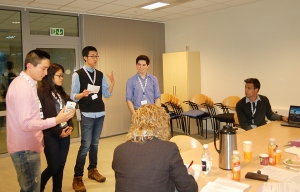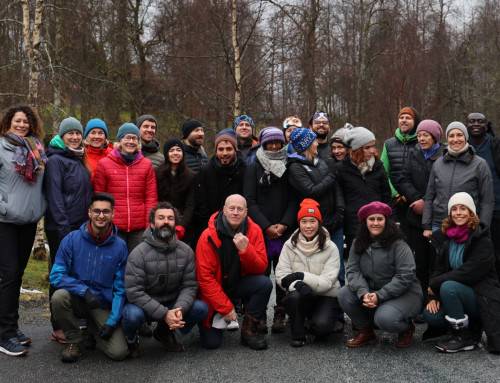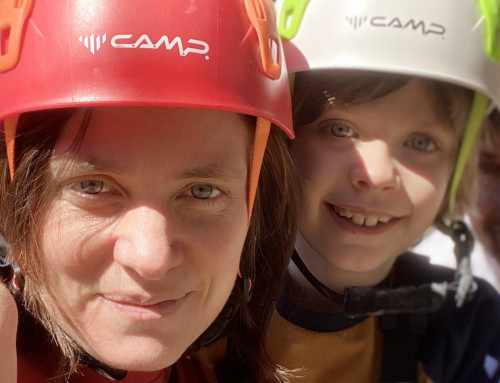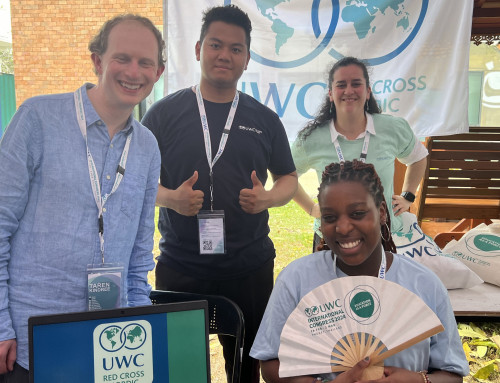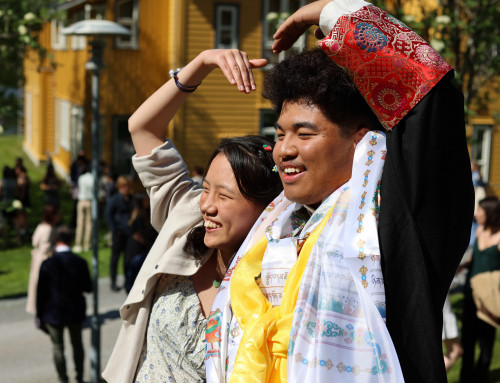On the 2nd of February, a non-Norwegian-speaking team of five students and one staff member set off to Trondheim to participate in a Norwegian-conducted national competition on energy innovation held by the Norwegian organisation Ungt Entreprenorskap.
Flying off to Trondheim in a small aeroplane, we were buzzing with anticipation as we contemplated meeting our Norwegian peers and engaging in meaningful debates about the state of the global climate today.
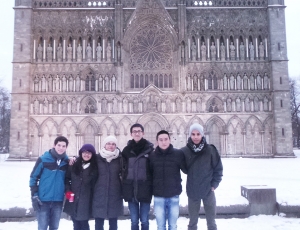 Before anything started, we first toured Trondheim. Led by our motherly leader – Judit Barbara Dudas – we marveled at the medieval Nidaros Cathedral as we slipped and shrieked on the icy ground, and experienced the budding consumerist culture of this city in its mall Trondheim Torg, where we tried to persuade Judit to buy us sushi. We failed.
Before anything started, we first toured Trondheim. Led by our motherly leader – Judit Barbara Dudas – we marveled at the medieval Nidaros Cathedral as we slipped and shrieked on the icy ground, and experienced the budding consumerist culture of this city in its mall Trondheim Torg, where we tried to persuade Judit to buy us sushi. We failed.
Filled with the pizza we had instead, we boarded a fleet of buses that whisked us to an arcade far away from the heart of the city. Bemused by the torrents of Norwegian, we blundered about, wailing “Du snakkar engelsk? Vi snakkar ikke norsk.” Luckily, we were saved by one of the organisers who explained to us that we were about to go go-karting and bowling. We saw this as a chance to integrate ourselves into Norwegian teenage society.
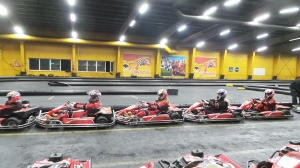 Observing safe driving regulations as we careened about the go-karting track and delicately rolling bowling balls with the poise of UWC students, we actually did manage to forge lasting relationships with some of our Norwegian peers. We realised that even though we might be different in some ways, we actually are concerned about the same issue and devoted to its solution – global warming.
Observing safe driving regulations as we careened about the go-karting track and delicately rolling bowling balls with the poise of UWC students, we actually did manage to forge lasting relationships with some of our Norwegian peers. We realised that even though we might be different in some ways, we actually are concerned about the same issue and devoted to its solution – global warming.
After experimenting with bowling techniques that ranged from the conventional to the forward-pelvic-pendulum-swing, we retired to our hotel.
The next day there were presentations by students from the Norwegian University of Science and Technology (NTNU) and corporate heads of ENOVA SF (the government corporation responsible for the promotion of environmentally friendly production and consumption of energy) about creative energy solutions. Exercises to stimulate creativity included connecting dots on paper with straight lines creatively, drawing spider diagrams creatively and devising quick solutions to reduce household energy consumption.
Then came the big moment – the announcement of the challenge for 2015’s ENOVA competition. It was probably very suspenseful as the head organiser gave her opening speech, but because it was in Norwegian none of us really understood. It was only when there was a collective intake of breath that we looked up and noticed that the Powerpoint presentation now read “transportsystem”.
After that, we were whisked to the high school where we would spend the next 24 hours labouring over our task – to develop a sustainable transportation system for a city. Charlottenlund VGS (where we were now domiciled) was a high school so modern and well-appointed that in any other country it would be considered a corporate building. We gawked at the sleek grey walls, the wooden banisters, the hospital-clean toilets and the modern colour scheme of black and orange.
Unfortunately, we did not stay for long because we were escorted to the sports hall that would be our true home until the final presentations. There we devised our strategy with invaluable assistance from our marshal, Judit. By attacking the problem with social advertising campaigns, technological innovation and governmental policies, we felt we were sure to win.
Five hours later, we weren’t so sure anymore. We were experiencing “demotivation” and “malaise” – states that were hitherto alien to us – as we waded through government research websites with carbon dioxide emission statistics and pollution taxation rates. However, it seemed that ENOVA had been expecting our willpower to drain at this point, for the organisers had prepared an hour-long “fun time”.
That “fun time” turned out to be physical time. At 10pm, we were escorted to another section of the sports hall with a team from Ringerike VGS from Buskerud and told to flip a huge mattress as many times as possible. We wondered whether this was a psychologist-approved method of stimulating creativity in adolescents. Or maybe it was just a way to make us sleepy so we would stop bothering the organisers. Either way, we were trapped in this.
Next up: weightlifting. This was just thoroughly embarrassing for us. The barbell had weights that looked like cute purple marshmallows but they were as heavy as 10 MacBooks Pros. While each of us took 10 seconds to lift up the whole thing, the Norwegian boys next to us were pumping their barbells up and down like they were chopsticks. Then it was dart-throwing to hone our mental precision but we only felt more muddled after that. The activity after that just seemed cruel – wall squats. With a middle-aged man watching us with a stopwatch in hand, all of us had to press our backs against the wall and whimper as the muscles in our thighs disintegrated. Embarrasingly enough (for us, anyway), the Norwegian boys were all practising proper breathing exercises and listening to the appropriate exercise tunes as they stoically tensed longer than us. The UWC-ers had all crumpled after 2 minutes.
Invigorated after that hour of exertion, we went back to our project refreshed.
We had brought sleeping bags, but those remained tightly bound as we pounded on our keyboards to 5am. Next to us, Norwegian teenagers inflated the air mattresses that they had brought with them – the mattresses looked bigger, and more comfortable, than the beds we have at UWCRCN!
At 7am, we hit ‘Send’ and our report was off to the organisers. At 7.30am, our guide, Judit, helped us practise our presentation even as we were collapsing from sleep deprivation.
At 9.20am, we presented! The jury was speechless after we drilled them with figures and equations (courtesy of Ricardo) but it was probably more due to confusion than awe.
Instead of announcing the finalists beforehand, we had to sit in the auditorium and wait as they were called one-by-one to present.
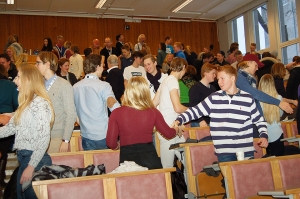 It was all bicycles and Maglev (magnetic levitation). Every idea consisted of building a Maglev subway system for the city. We should have done Maglev. We thought we were going to be placed as the last finalist for theatrical purposes but the last finalist was another Maglev group.
It was all bicycles and Maglev (magnetic levitation). Every idea consisted of building a Maglev subway system for the city. We should have done Maglev. We thought we were going to be placed as the last finalist for theatrical purposes but the last finalist was another Maglev group.
Judit comforted us as we left the auditorium with our heads down and our hearts heavy. Even though we didn’t win anything, we were glad that we had gone through this experience. We had come together as a team and worked together even as we sank further into despair and exhaustion. We had forged new friendships with our Norwegian peers and had strengthened existing ones amongst ourselves. And most importantly, we had learnt that Norwegian high school competitions always involve hidden physical activities – and Maglev.
Brandon Mok (UWC RCN 2013-2015)


